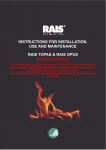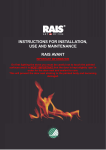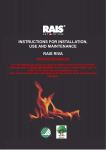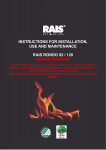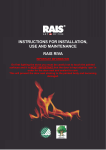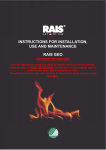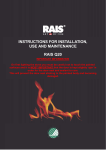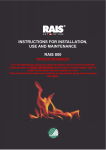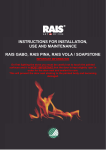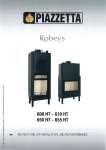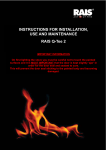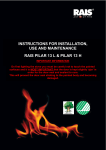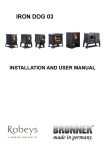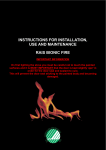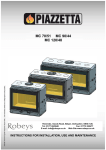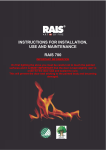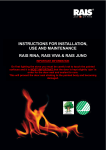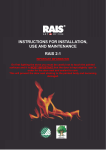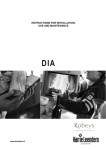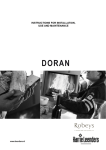Download RAIS Q-Tee 2 Specifications
Transcript
ENGLISH RAIS manual for Rais QTee INSTRUCTIONS FOR INSTALLATION, USE AND MAINTENANCE RAIS QTEE IMPORTANT INFORMATION On first lighting the stove you must be careful not to touch the painted surfaces and it is MOST IMPORTANT that the door is kept slightly ‘ajar’ in order for the door seal and sealant to cure. This will prevent the door seal sticking to the painted body and becoming damaged. 1 ENGLISH RAIS manual for Rais QTee 2 ENGLISH RAIS manual for Rais QTee Revision : Date : 2011 INTRODUCTION ………………………………………………………….. 4 WARRANTY …………………………………………………….………….. 4 SPECIFICATIONS ………………………………………………………….. 5 CONVECTION ………………………………………………………………. 6 INSTALLATION INSTRUCTIONS ………………………………….……… 7 CHIMNEY …………………………………………………….…………. 89 HEARTH ………………………………………………………………… 9 INSTALLATION ………………………………………………..……... 11 COMMISSIONING AND HANDOVER ……………………………… 11 MANUFACTURERS PLATE ………………………………………………. 12 CHANGING THE CHIMNEY CONNECTION …………………………….. 13 INSTALLATION DISTANCE TO COMBUSTIBLE WALL …………....... 1416 INSTALLATION DISTANCE TO NONCOMBUSTIBLE WALL ……… 17 FOR THE INSTALLER ……………………………………………………… 17 OPERATING INSTRUCTIONS …………………………………………….. 22 FUEL …………………………………………………………………………... 22 DRYING AND STORAGE …………………………………………………… 23 REGULATION OF COMBUSTION AIR …………………………………… 23 ROOM VENTILATION AND STOVES …………………………………….. 23 USING THE WOOD BURNING STOVE …………………………………… 24 FIRST USAGE ………………………………………………………………… 25 LIGHTING AND FUELLING ………………………………………………… 2627 CLEANING AND CARE …………………………………………………….. 28 CLEANING OF THE FLUE WAYS ………………………………………… 29 PROBLEM SOLVING ……………………………………………………….. 30 ACCESSORIES AND SPARE PARTS ……………………………………. 31 SPARE PART DIAGRAM …….………..……………………………………. 3233 FITTING THE DIRECT AIR BOX …………………………………………… 3435 LOCK BLOCK FOR STEEL DOORS ………………………………………. 36 QUICK GUIDE …………………………………………………………………. 37 3 ENGLISH RAIS manual for Rais QTee Introduction Thank you for purchasing a Rais wood burning stove. These appliances have been approved by SCA / HETAS as intermittent operating appliances for burning wood logs only. These appliances have been approved for use in Smokeless Zones A Rais wood burning stove is more than just a heat source: it also shows that you care about design and quality in your home. To make the most of your wood burning stove it is important that you read the manual thoroughly before installing and using it. In the case of warranty coverage, and for general queries regarding your wood burning stove, it is important that you know the stove’s production number. We therefore recommend that you note down the number in the table below. The production number is located at the back of the stove at the bottom. Warranty Your Rais wood burning stove comes with a 5 year warranty. The warranty, however, does not cover heatinsulating materials, glass and seals. These are available to order from your local Rais dealer / stockist. Any alterations made to the stove will void the warranty. 4 5 20 3.7 283 Dust measured according to Din+ (mg/Nm 3 ) Smoke gas mass flow (g/s): Smoke gas temperature (°C): Fuelling should be undertaken within 3 hours 283 3.7 20 3.6 73 82 / 84 12 1.5 317 / 270 / 270 425 / 372 / 650 Ca. 3090 4 5 4.7 QTee 65 Fuelling should be undertaken within 3 hours 283 3.7 20 3.6 73 94 / 96 12 1.5 317 / 270 / 270 425 / 372 / 850 Ca. 3090 4 5 4.7 QTee 85 Please Note, this appliance has been tested by the manufacturers and works on a 3m straight flue. Fuelling should be undertaken within 3 hours 3.6 Particles after NS3058/3059 (g/kg) Intermittent operation: 73 Efficiency ( % ) 79 / 81 12 Min. uptake / Min. draught (Pascal): Weight (kg): ( Steel Door / Glass Door ) 1.5 317 / 270 / 270 Combustion chamber width/depth/height (mm). Recommended amount of wood when fuelling (kg) (Based on 2 3 logs of wood approx. 25cm) 425 / 372 / 570 Size, width/depth/height (mm): Ca. 3090 4 5 Min. / Max. output (kW): Heating area (m 2 ): 4.7 Nominal output (kW): QTee 57 ENGLISH RAIS manual for Rais QTee Specifications ENGLISH RAIS manual for Rais QTee Convection Rais stoves are convection stoves. This means that the stove’s back and side panels are not overheated. Convection means that there is a circulation of air, which ensures that the heat is distributed more evenly throughout the entire room. The cold air is sucked in at the base of the stove and up through the convection channel, which runs along the stove’s combustion chamber. The heated air comes out at the top of the stove, which ensures a circulation of warm air throughout the room. The stoves are equipped with cool door handles a Rais special feature which means you could almost do away with gloves. Be aware, however, that all exterior surfaces become hot during use so take extreme care. 6 ENGLISH RAIS manual for Rais QTee These instructions together with those in the instruction booklet cover the basic principles to ensure the satisfactory installation of the stove, although detail may need slight modification to suit particular local site conditions. In all cases the installation must comply with current Building Regulations, Local Authority Byelaws and other specifications or regulations as they affect the installation of the stove. It should be noted that the Building Regulations requirements may be met by adopting the relevant recommendations given in British Standards BS 8303, BS EN 152871:2007 as an alternative means to achieve an equivalent level of performance to that obtained following the guidance given in Approved Document J. Please note that it is a legal requirement under England and Wales Building Regulations that the installation of the stove is either carried out under Local Authority Building Control approval or is installed by a Competent Person registered with a Government approved Competent Persons Scheme. HETAS Ltd operate such a Scheme and a listing of their Registered Competent Persons can be found on their website at www.hetas.co.uk. CO Alarms: Building regulations require that when ever a new or replacement fixed solid fuel or wood/biomass appliance is installed in a dwelling a carbon monoxide alarm must be fitted in the same room as the appliance. Further guidance on the installation of the carbon monoxide alarm is available in BS EN 50292:2002 and from the alarm manufacturer’s instructions. Provision of an alarm must not be considered a substitute for either installing the appliance correctly or ensuring regular servicing and maintenance of the appli ance and chimney system. HEALTH AND SAFETY PRECAUTIONS Special care must be taken when installing the stove such that the requirements of the Health and Safety at Work Act are met. Handling Adequate facilities must be available for loading, unloading and site handling. Fire Cement Some types of fire cement are caustic and should not be allowed to come into contact with the skin. In case of contact wash immediately with plenty of water. Asbestos This stove contains no asbestos. If there is a possibility of disturbing any asbestos in the course of installation then please seek specialist guidance and use appropriate protective equipment. Metal Parts When installing or servicing this stove care should be taken to avoid the possibility of personal injury. 7 ENGLISH RAIS manual for Rais QTee STOVE PERFORMANCE In the UK the stove has been approved by HETAS Ltd as an intermittent operating appliance for burning wood logs only. PREPARATORY WORK AND SAFETY CHECKS IMPORTANT WARNING This stove must not be installed into a chimney that serves any other heating appliance. There must not be an extractor fan fitted in the same room as the stove as this can cause the stove to emit fumes into the room. Chimney In order for the stove to perform satisfactorily the chimney height must be sufficient to ensure an adequate draught of approximately 15 Pa so as to clear the products of combustion and prevent smoke problems into the room. NOTE: A chimney height of not less than 4.5 metres measured vertically from the outlet of the stove to the top of the chimney should be satisfactory. Alternatively the calculation procedure given in EN 133841 may be used as the basis for deciding whether a particular chimney design will provide sufficient draught. Please Note, this appliance has been tested by the manufacturers and works on a 3m straight flue. The outlet from the chimney should be above the roof of the building in accordance with the provisions of Building Regulations Approved Document J. If installation is into an existing chimney then it must be sound and have no cracks or other faults which might allow fumes into the house. Older properties, especially, may have chimney faults or the cross section may be too large i.e. more than 230 mm x 230 mm. Remedial action should be taken, if required, seeking expert advice, if necessary. If it is found necessary to line the chimney then a flue liner suitable for solid fuel must be used in accordance with Building Regulations Approved Document J. Any existing chimney must be clear of obstruction and have been swept clean immediately before installation of the stove. If the stove is fitted in place of an open fire then the chimney should be swept one month after installation to clear any soot falls which may have occurred due to the difference in combustion between the stove and the open fire. If there is no existing chimney then either a prefabricated block chimney in accordance with Building Regulations Approved Document J or a twin walled insulated stainless steel flue to BS 4543 can be used. These chimneys must be fitted in accordance with the manufacturer’s instructions and Building Regulations. 8 ENGLISH RAIS manual for Rais QTee A single wall metal fluepipe is suitable for connecting the stove to the chimney but is not suitable for using for the complete chimney. The chimney and connecting fluepipe must have a minimum diameter of 125 mm and its dimension should be not less than the size of the outlet socket of the stove. Any bend in the chimney or connecting fluepipe should not exceed 45°. 90° bends should not be used. Combustible material should not be located where the heat dissipating through the walls of fireplaces or flues could ignite it. Therefore when installing the stove in the presence of combustible materials due account must be taken of the guidance on the separation of combustible material given in Building Regulations Approved Document J and also in these stove instructions. If it is found that there is excessive draught in the chimney then a draught stabiliser should be fitted. Fitting of a draught stabiliser will affect the requirement for the permanent air supply into the room in which the stove is fitted in accordance with Approved Document J (see also combustion air supply). Adequate provision e.g. easily accessible soot door or doors must be provided for sweeping the chimney and connecting fluepipe where it is not intended for the chimney to be swept through the appliance, also to permit visual checks on the integrity of the flue when the appliance is serviced. Hearth The hearth should be able to accommodate the weight of the stove and its chimney if the chimney is not independently supported. The weight of the stove is indicated in the brochure. The stove should always be installed on a noncombustible hearth of a size and construction that is in accordance with the provisions of the current Building Regulations Approved Document J. The clearance distances to combustible material beneath, surrounding or upon the hearth and walls adjacent to the hearth should comply with the guidance on the separation of combustible material given in Building Regulations Approved Document J and also in these stove instructions. If the stove is to be installed on a combustible floor surface, it must be covered with a noncombustible material at least 12mm thick, in accordance with Building Regulations Approved Document J, to a distance of 30 cm in front of the stove and 15 cm to each side measuring from the door of the combustion chamber. 9 ENGLISH RAIS manual for Rais QTee Combustion air supply In order for the stove to perform efficiently and safely there should be an adequate air supply into the room in which the stove is installed to provide combustion air. This is particularly necessary if the room is doubleglazed or a flue draught stabiliser is operat ing in the same room as the appliance. It may be necessary to increase the air vent size in property with low air permeability ( < 5.0 m 3 /(h.m 2 ). The provision of air supply to the stove must be in accordance with current Building Regulations Approved Document J. An opening window is not appropriate for this purpose. IMPORTANT NOTE: If applicable and the appliance is being fitted within an existing fireplace recess, specialist advice should be sought before fitting any permanent ventilation within this area. Connection to chimney Stoves may have a choice of either a rear or top flue gas connector that allows connection to either a masonry chimney or a prefabricated factory made insulated metal chimney in accordance with their instructions. In some cases it may be necessary to fit an adaptor to increase the diameter of the flue to the minimum required 150 mm section of the chimney or liner. Electrical Services The installation of any electrical services during the installation of this appliance must be carried out by a registered competent electrician and in accordance with the requirements of the latest issue of BS 7671 Carbon Monoxide Alarm A carbon monoxide alarm complying with BS EN 50292 must be fitted in the same room as the appliance. It should be positioned on the ceiling at least 300mm from any wall or, if it is located on a wall, as high up as possible (above any doors and windows) but not within 150mm of the ceiling. The alarm should also be between 1m and 3m horizontally from the appliance. 10 ENGLISH RAIS manual for Rais QTee Commissioning and handover Ensure loose parts are fitted in accordance with the instructions given in the instruction booklet. On completion of the installation allow a suitable period of time for any fire cement and mortar to dry out, when a small fire may be lit and checked to ensure the smoke and fumes are taken from the stove up the chimney and emitted safely to atmosphere. Do not run at full output for at least 24 hours. On completion of the installation and commissioning ensure that the operating instructions for the stove are left with the customer. Ensure to advise the customer on the correct use of the appliance with the fuels likely to be used on the stove and warn them to use only the recommended fuels for the stove. Advise the user what to do should smoke or fumes be emitted from the stove. The customer should be warned to use a fireguard to BS 8423:2002 (Replaces BS 6539) in the presence of children, aged and/or infirm persons. Installation It is prohibited to carry out unauthorised alterations to the stove. There must be plenty of fresh air in the room where the stove is being installed, in order to ensure proper combustion. Note that any mechanical exhaust ventilation e.g. an extraction hood may reduce the air supply. Any air grilles must be placed in such a manner, that the air supply is not blocked. Building Regulations Approved Document J gives specific guidance on the required permanent ventilation into the room for combustion air of solid fuel appliances. The floor structure must be able to carry the weight of the wood burning stove, as well as the weight of a chimney, if necessary. When you choose where to set up your RAIS wood burning stove, you should consider the heat distribution to the other rooms. This will enable you to get the best use out of your stove. The stove should be set up at a safe distance from inflammable materials. See the manufacturer's plate on the wood burning stove. 11 ENGLISH RAIS manual for Rais QTee 12 ENGLISH RAIS manual for Rais QTee Changing the chimney connection Remove the casing knockout. Remove the protective cover / seal and place over the hole in the top make sure that the seal is positioned properly. Tighten the assembly using the three M6 nuts. The flue outlet spigot, which can be found in the stove in a bag, and the holder for the upper flue diverter are assembled with 3 M6 x 20 nuts and bolts. The upper flue diverter, baffle plate and top plate are assembled in reverse order. 13 ENGLISH RAIS manual for Rais QTee Installation distance to combustible wall To find out whether the wall next to where the stove is going to be installed is flammable, you should contact your building contractor or the local building authorities. The hearth should be able to accommodate the weight of the stove. The chimney must be independently supported by wall brackets or a ceiling support plate. The weight of the stove is indicated in the brochure. The stove should always be installed on a noncombustible hearth of a size and construction that is in accordance with the provisions of the current UK Building Regulations Approved Document J. If the stove is to be installed on a wooden floor, it must be covered with a noncombustible material at least 12mm thick, in accordance with UK Building Regulations Approved Document J, to a distance of 300 mm in front of the stove and 150 mm to each side measuring from the door of the combustion chamber. The clearance distances to combustible material beneath, surrounding or upon the hearth and walls adjacent to the hearth should comply with the guidance on the separation of combustible material given in UK Building Regulations Approved Document J and also in these stove instructions. Inform the user that the appliance has been commissioned and ready to use and give instruction on the safe operation of the stove. These Instructions must be left with the user and the user should be instructed to keep them in a safe place. 14 ENGLISH RAIS manual for Rais QTee Normal setup corner setting A. Distance to furniture Uninsulated flue 650 mm Insulated flue 650 mm Distance to flammable materials: B. in front (floor) 300 mm 300 mm C. to the side (floor) 150 mm 150 mm D. to the rear (floor) 350 mm 275 mm E. to the side of the wall 275 mm 225 mm 15 ENGLISH RAIS manual for Rais QTee Corner setting 45° fixed socket A. Distance to furniture Un insulated flue 650 mm Insulated flue 650 mm Distance to flammable materials: B. in front (floor) 300 mm 300 mm C. to the side (floor) 150 mm 150 mm D. to the rear (wall) 225 mm 175 mm E. to the side of the wall 275 mm 225 mm 16 ENGLISH RAIS manual for Rais QTee Installation distance in case of noncombustible wall We recommend a minimum distance to noncombustible material of 50 mm (F) for cleaning considerations. Using uninsulated flue pipe, the minimum distance to a combustible wall must be 450mm or 225mm if the wall is heatshielded ( see Section J of the Building Regu lations ) from the flue pipe. For the Installer Finally before firing the stove for the first time a check should be made to ensure that the assembly and stove installation has been satisfactory and that there are no leaks in any seals in the appliance and appliance connections to the chimney. Ensure that the appliance and chimney flue are functioning correctly before finally handing over to the user. If necessary read the later parts of this manual for guidance on care required when first lighting. Inform the user that the appliance has been commissioned and ready to use and give instruction on the safe operation of the stove. These Instructions must be left with the user and the user should be instructed to keep them in a safe place. 17 ENGLISH RAIS manual for Rais QTee WARNING NOTE Properly installed, operated and maintained this stove will not emit fumes into the dwelling. Occasional fumes from de‑ashing and re‑fuelling may occur. However, persistent fume emission is potentially dangerous and must not be tolerated. In the event of fume emission from the appliance, then the following immediate action should be taken: ‑ (a) Open doors and windows to ventilate room and then leave the premises (b) Let the fire go out (c) When safe to do so, check for flue or chimney blockage and clean if required (d) Do not attempt to relight the fire until the cause of the fume emission has been identified and corrected. If necessary seek expert advice. The most common cause of fume emission is flueway or chimney blockage. For your own safety these must be kept clean at all times. IMPORTANT NOTES General Before lighting the stove check with the installer that the installation work and com missioning checks described in the installation instructions have been carried out correctly and that the chimney has been swept clean, is sound and free from any obstructions. As part of the stoves’ commissioning and handover the installer should have shown you how to operate the stove correctly. CO Alarm Your installer should have fitted a CO alarm in the same room as the appliance. If the alarm sounds unexpectedly, follow the instructions given under “Warning Note” above. Use of fireguard When using the stove in situations where children, aged and/or infirm persons are present a fireguard must be used to prevent accidental contact with the stove. The fireguard should be manufactured in accordance with BS 8423:2002 (Replaces BS 6539). If the fire is left unattended a spark guard to BS 3248, specification for spark guards for use with solid fuel appliances should be used. Chimney cleaning The chimney should be swept at least twice a year. It is important that the flue con nection and chimney are swept prior to lighting up after a prolonged shutdown pe riod. 18 ENGLISH RAIS manual for Rais QTee If the stove is fitted in place of an open fire then the chimney will require sweeping after a month of continuous operation. This is a precaution to ensure that any “softer” deposits left from the open fire usage have not been loosened by the higher flue temperatures generated by the closed stove. In situations where it is not possible to sweep through the stove the installer will have provided alternative means, such as a soot door. After sweeping the chim ney the stove flue outlet and the flue pipe connecting the stove to the chimney must be cleaned with a flue brush. Special Notes for use in a Smoke Control Area (Rais QTee): Refuelling on to a low fire bed If there is insufficient burning material in the firebed to light a new fuel charge, ex cessive smoke emission can occur. Refuelling must be carried out onto a sufficient quantity of glowing embers and ash that the new fuel charge will ignite in a reason able period. If there are too few embers in the fire bed, add suitable kindling to pre vent excessive smoke Fuel overloading The maximum amount of fuel specified in this manual should not be exceeded, overloading can cause excess smoke. Operation with door left open Operation with the door open can cause excess smoke. The appliance must not be operated with the appliance door left open except as directed in the instruc tions. Dampers left open Operation with the air controls or dampers open can cause excess smoke. The ap pliance must not be operated with air controls or dampers door left open except as directed in the instructions. Periods of Prolonged NonUse If the stove is to be left unused for a prolonged period of time then it should be given a thorough clean to remove ash and unburned fuel residues. To enable a good flow of air through the appliance to reduce condensation and subsequent damage, leave the air controls fully open. Extractor fan There must not be an extractor fan fitted in the same room as the stove as this can cause the stove to emit smoke and fumes into the room. Aerosol sprays Do not use an aerosol spray on or near the stove when it is alight. Use of operating tools Always use the operating tools provided when handling parts likely to be hot when the stove is in use. 19 ENGLISH RAIS manual for Rais QTee Chimney Fires If the chimney is thoroughly and regularly swept, chimney fires should not occur. However, if a chimney fire does occur turn off the stove immediately and isolate the mains electricity supply (if applicable), and tightly close the doors of the stove. This should cause the chimney fire to go out. If the chimney fire does not go out when the above action is taken then the fire brigade should be called immediately. Do not relight the stove until the chimney and flueways have been cleaned and ex amined by a professional. Permanent air vent The stove requires a permanent and adequate air supply in order for it to operate safely and efficiently. In accordance with current Building Regulations the installer may have fitted a per manent air supply vent into the room in which the stove is installed to provide com bustion air. This air vent should not under any circumstances be shut off or sealed. USER OPERATING INSTRUCTIONS WOOD Please read the important notices given above before referring to the main instruc tion book for detailed operating instructions. HETAS Ltd Approval HETAS approval may be limited to specific fuel types as detailed in the main in struction manuals. Approval does not cover the use of other fuels either alone or mixed with the recommended fuel, nor does it cover instructions for the use of other fuels. Recommended fuels Stoves may be designed to burn dry seasoned wood logs and/or solid mineral fuel as indicated in the main stove manuals. Door operation The door handle may become hot during operation, use the tool to open and close the doors, if appropriate. Lighting of fire Place some firelighters or paper and dry kindling wood on the grate and cover with a small amount of fuel. Set air controls to maximum and set light to firelighters or paper. Close the doors and allow fire to burn until fuel is well alight then load with more fuel and adjust air controls to the required level of heat output. Before relighting the fire clean the firebed of ash and clinker and empty the ashpan. 20 ENGLISH RAIS manual for Rais QTee Refuelling Keep the firebox well filled (the fuel may be sloped up from the front firebars), but do not allow fuel to spill over the top of the front fire bars. Take care that fuel does not project over the front fire bars or damage to the glass may be caused when the doors are closed Flueway cleaning It is important that the baffle plate and all the stove flueways are kept clean. When burning smokeless fuels they should be cleaned at least monthly. When burning other fuels they should be cleaned at least once a week, and more frequently if necessary. Remove any sooty deposits from the baffle plate until they fall off into the fire. More soot will be deposited on the baffle plate and in the flueways if the stove is run at low levels for long periods. If this is the case then more frequent cleaning will be necessary. Cleaning and maintenance The instructions detailed in the section “Maintenance” in the instruction booklet should be followed. Spare Parts Spare parts can be obtained from Robeys Limited 01773 820 940 Trouble shooting The instructions detailed in the relevant section in the instruction booklet should be followed together with the following additional items: 1. Fire Will Not Burn Check that: a) the air inlet is not obstructed in any way, b) that chimneys and flueways are clear, c) that a suitable fuel is being used, d) that there is an adequate air supply into the room, e) that an extractor fan is not fitted in the same room as the fire. 2. Fire Blazing Out Of Control Check that: a) the doors are tightly closed, b) the air control is turned down to the minimum setting, c) the air inlet damper is closed and that it is not prevented from closing com pletely by a piece of ash, d) a suitable fuel is being used, e) the door seals are in good condition. 21 ENGLISH RAIS manual for Rais QTee Operating instructions Please note that HETAS Appliance Approval only covers the use of dry seasoned wood logs on this appliance. HETAS Approval does not cover the use of other fuels either alone or mixed with the wood logs, nor does it cover instructions for the use of other fuels. Fuel The stove is designed and approved in accordance with EN 13240 and NS 3058 for stoking split, dried firewood. The firewood must have a water content of 1522% and its max. length should be the length of the combustion chamber minus 5060 mm. Stoking with wet firewood causes both soot, environmental pollution and bad fuel economy. Freshly cut wood contains approx. 5070% water and is thoroughly unsuitable for stoking. Allow at least 1 year of storage time for newly cut wood before using. Wood with a diameter of more than 100 mm should be split. Regardless of wood size, it should always have at least one surface area free of bark. We do not recommend stoking with painted, laminated or impregnated wood, wood with a synthetic surface, painted refuse wood, chipboard, plywood, domestic waste, paper briquettes and pit coal, as this will produce malodorous smoke, which could be poisonous. When firing with the abovementioned items and amounts larger than those recommended, the stove is subjected to a larger amount of heat, which results in a higher chimney temperature and lower efficiency. This can result in the stove and chimney becoming damaged and would void the warranty. The calorific value of the firewood is closely connected to the moisture level. Moist firewood has a low heat value. The more water the wood contains, the more energy it takes for this water to vaporise, resulting in this energy being lost. ONLY USE RECOMMENDED FUELS The following table shows the calorific value of different types of wood, which have been stored for 2 years and which have a residual moisture of 15 17%. Wood Kg dry wood pr m 3 compared to beech/oak Hornbeam 640 110% Beech and oak 580 100% Ash 570 98% Maple 540 93% Birch 510 88% Mountain pine 480 83% Fir 390 67% Poplar 380 65% 1kg of wood yields the same heat energy irrespective of wood type. 1kg of beech merely takes up less space than 1kg of fir. 22 ENGLISH RAIS manual for Rais QTee Drying and storage Drying wood takes time: proper air drying takes approximately 2 years. Here are some tips: Store the wood sawn, split and stacked in an airy, sunny place, which is protected against rain (the south side of the house is particularly suitable). Store the firewood stacks at a hand's breadth apart, as this ensures that the air flowing through takes the moisture with it. Avoid covering the firewood stacks with plastic, as this prevents the moisture from escaping. It is a good idea to bring the firewood into the house 23 days before you need it. Regulating the combustion air All RAIS stoves are equipped with a onehanded operating lever for regulating the damper. The stovespecific regulating mechanisms can be seen on the diagrams. Primary air is the combustion air added to the primary combustion zone, i.e. the bed of glowing embers. This air, which is cold, is only used in the lighting stage. Secondary air is the air which is added in the gas combustion zone, i.e. air which contributes to the combustion of the pyrolysis gasses (preheated air, which is used for the cleaner glass system and combustion). This air is sucked through the damper under the combustion chamber and is preheated through the side channels and then emitted as hot scavenging air onto the glass. The hot air rinses the glass and keeps it sootfree. The tertiary channel, which can be seen at the top of the combustion chamber towards the back, serves to combust the final gas residues. By setting the interval between position 1 and 2, the energy content in the firewood is used optimally, as there is oxygen for combustion and for the burning of the pyrolysis gasses. When the flames are a clear yellow the damper has been set correctly. Finding the correct position comes with time after you have used for stove for a while. It is not recommended that you turn it down completely. A mistake commonly made is shutting the damper too early because it feels too hot. This results in dark smoke emanating from the chimney and in the calorific value of the firewood not being used to its fullest. Room ventilation and stoves There must not be an extractor fan fitted in the same room as the stove as this can cause the stove to emit smoke and fumes into the room. The stove requires a permanent and adequate air supply in order for it to operate safely and efficiently. In accordance with current Building Regulations the installer may have fitted a permanent air supply vent into the room in which the stove is installed to provide combustion air. This air vent should not under any circumstances be shut off or sealed. 23 ENGLISH RAIS manual for Rais QTee Using the wood burning stove Adjusting the air damper. The damper has 3 settings. Position 1 The damper is almost closed meaning that there is a minimal air intake. Position 2 Pull / push the lever until the first click. This position gives full secondary air. During normal use the lever is set between position 1 and 2. When the flames are clear and yellow, the damper is set correctly, i.e. resulting in a slow/optimal burning. Position 3 Pull / push the lever until the next click. The air damper is completely open and gives full primary and secondary air. This position is for the lighting stage and is not used under normal operation. Control If the ash is white and the walls in the combustion chamber are soot free after the stove has been used, the air regulation was set correctly and the wood was sufficiently dry. 24 ENGLISH RAIS manual for Rais QTee First usage A careful start pays off. Start with a small fire, so that the wood burning stove can get accustomed to the high temperature. This gives the best start and any damage is avoided. Be aware that a strange but harmless odour and smoke concoction may emanate from the surface of the stove, the first time you fire up. This is because the paint and materials need to harden. The odour disappears quickly, but you should check the ventilation and draught, if possible. See also, the IMPORTANT warning notice below about persistent fumes. During this process you must be careful not to touch the painted surfaces, and it is recommended that you regularly open and close the door to prevent the door seal from sticking. The stove may also produce "clicking noises" during heating and cooling, caused by the large temperature differences which the material is subjected to. Never use any type of liquid fuel for kindling or maintaining the fire. You could be at risk of explosion. The stove gets very hot when in use, always wear protective gloves when tending the stove. If the stove has not been used for a while, follow the steps as if you were using it for the first time. IMPORTANT Warning Note! Properly installed, operated and maintained this appliance will not emit fumes into the dwelling. Occasional fumes from deashing and refuelling may occur. However, persistent fume emission is potentially dangerous and must not be tolerated. If fume emission does persist, the following immediate actions should be taken: (a) (b) (c) (d) Open doors and windows to ventilate room. Let the fire out or eject and safely dispose of fuel from the appliance. Check for flue or chimney blockage, and clean if required. Do not attempt to relight the fire until the cause of the fume emission has been identified and corrected. If necessary seek expert advice. IMPORTANT Warning Note! Do not use an aerosol spray on or near the stove when it is alight. IMPORTANT Safety advice! When using the stove in situations where children, aged and/or infirm persons are present a fireguard must be used to prevent accidental contact with the stove. The fireguard should be manufactured in accordance with BS 8423:2002 (Replaces BS 6539). 25 ENGLISH RAIS manual for Rais QTee Lighting and fuelling "TopDown" lighting Start by placing 34 pieces wood approx. 1 ½ 2 kilogram in the bottom of the burning chamber. Place approx. 1 kilogram of dry firewood, split into kindling sticks., and a couple of alcohol briquettes or similar (12). Set the air damper to fully open position. Light the fire and close the door (34). When the flames are clear after approx. 1015 min close the door completely (5). Damper see adjustment of air damper. When the last flames are extinguished and there is a nice layer of embers (5), add 23 pieces of wood. Close the door and once the fire has a good hold closed door completely. Damper see adjustment of air damper. After approx. 5 min or when the flames are clear and stable (6) close the damper gradually. Note!!! Keep an eye on the stove when lighting. During operation the door should always remain shut. 26 ENGLISH RAIS manual for Rais QTee 27 ENGLISH RAIS manual for Rais QTee Cleaning and care The wood burning stove and the chimney must be serviced by a chimney sweep twice a year. During cleaning and care, the stove must be cold. If the glass is sooty: Moisten a piece of paper or newspaper, dip it in the ash, and rub the sooty glass with it. Now rub with a dry piece of paper and the glass will become clean. As an alternative you can use glass cleaner, which you can buy from you RAIS distributor. Clean the exterior with a dry sponge or a soft brush. Cleaning the combustion chamber: Scrape/shovel the ash out and store it in a nonflammable container until it has cooled down. You can dispose of ash with your normal household waste or recycle on the garden. REMEMBER!! Never remove all the ashes from the combustion chamber the wood will burn at its best with a layer of ashes of approx. 20 mm. Prolonged periods of nonuse: If the stove is to be left unused for a prolonged period of time then it should be given a thorough clean to remove ash and unburned fuel residues. To enable a good flow of air through the appliance to reduce condensation and subsequent damage, leave the air controls fully open. Prior to a new heating season, it should be checked that the chimney and flue pipe connector are not blocked. 28 ENGLISH RAIS manual for Rais QTee Cleaning of flue way The flue ways are consist of a smoke converter plate and a smoke chicane. Both parts are made of vermiculite. Handle these parts carefully. Remove the smoke converter plate by tilting it to one side and turning it a little slantwise. Pull out the plate carefully. Then remove the smoke baffle by pushing it backwards, tipping it up on one side and turn slightly tilted. Carefully lift out the smoke baffle. Remove dirt and dust, and mount the parts in reverse order. 29 ENGLISH RAIS manual for Rais QTee Problem solving Smoke spillage around door: could be due to too low draught in the chimney <12Pa check if the flue or chimney is blocked check if a extraction hood is switched on; if it is, switch it off and open a window/door in the proximity of the stove for a short while. Soot on glass: could be because the firewood is too wet. make sure that the stove is heated properly when firing up, prior to closing the door could be because the damper regulation is too low. A stove burning too strong could be caused by: a leak around the door seal chimney draught too large >22 Pa, draught control regulator should be installed. A stove burning too weakly could be caused by: too little firewood too little air supply for the room ventilation dirty smoke channels leaking chimney leakage between chimney and flue If your stove continues to malfunction, we recommend that you contact your RAIS distributor or chimney sweep. IMPORTANT!! To ensure safe burning there must be clear yellow flames or clear embers at all times. The firewood should not be smouldering. Therefore you should never completely cut off the air supply. WARNING!! In case of chimney fire: shut off all air supply on the wood burning stove contact the fire services never attempt to put out fire with water! afterwards, you should ask your chimney sweep to check the stove and chimney 30 ENGLISH RAIS manual for Rais QTee Accessories and spare parts If spare parts other than those recommended by RAIS are used, the warranty is voided. All replacement spare parts can be purchased from your RAIS distributor / stockist. See the following spare parts diagrams for the individual products. 8351790 Airbox 835040190 Socket 31 ENGLISH RAIS manual for Rais QTee Spare parts diagram Rais QTee Pos./Ref. Quantity Part no.: Description 1 1 835010390 Mantle QTee 65 2 1 835010290 Mantle QTee 57 3 1 8352090 Steel door 4 1 8351090 Glass door 5 1 835052490 Cover QTee 57 6 1 835050490 Cover QTee 65 7 1 8352200 Fire brick set 8 1 8353800 Shaking grate 9 1 8354001 Ash pan 10 1 6100 Flue collar 6" 11 1 61105 Flue collar 5" 12 1 8350990 Air damper 13 1 8355500 Seal set 32 ENGLISH RAIS manual for Rais QTee 33 ENGLISH RAIS manual for Rais QTee 34 ENGLISH RAIS manual for Rais QTee 35 ENGLISH RAIS manual for Rais QTee 36 ENGLISH RAIS manual for Rais QTee 37 ENGLISH RAIS manual for Rais QTee 38 ENGLISH RAIS manual for Rais QTee 39 ENGLISH RAIS manual for Rais QTee 40 ENGLISH RAIS manual for Rais QTee 41 ENGLISH RAIS manual for Rais QTee U K Distributor. Robeys Ltd. Riverside, Goods Road, Belper, Derbyshire, England. DE56 1UU Tel: 01773 820940 Fax: 01773 820477 E Mail: [email protected] www.robeys.co.uk June 2011 42










































